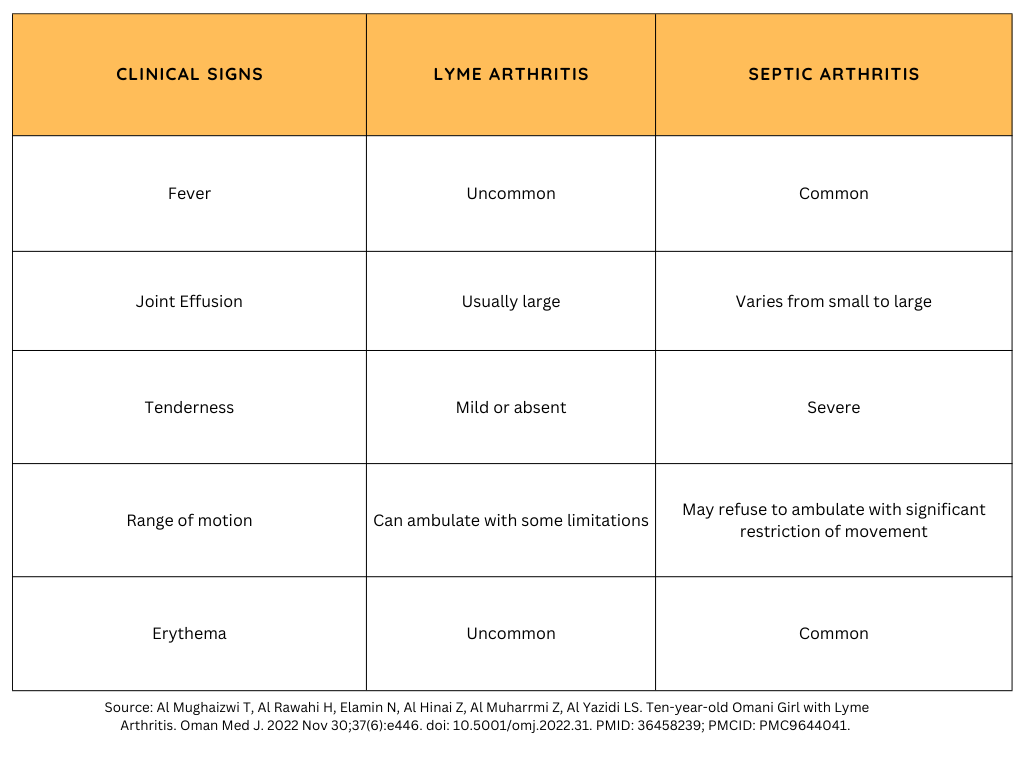Call for your appointment today 914-666-4665 | Mt. Kisco, New York

In their article, “Ten-year-old Omani Girl with Lyme Arthritis,” Mughaizwi and colleagues describe a young child who had lived in the United States for 5 years before moving to Oman.¹ One year after her return to Oman, she developed symptoms of Lyme arthritis.
“We report a 10-year-old girl who presented with acute arthritis of the left knee, which was confirmed as Lyme arthritis by serology and molecular assay,” the authors wrote.
The patient had lived in upstate New York for several years and recalled having 2 tick bites. The bites occurred 2-3 years prior to her onset of symptoms.
One year after returning to Oman, the young child began experiencing pain and swelling in her left knee, which worsened over the course of a week. She reportedly had no other physical complaints or joint pain.
“Our patient gave a history of tick bites at least a year prior to her current presentation.”
An examination “revealed marked left knee swelling, mildly tender and warm to touch, extending 2 cm above and below the knee joint,” the authors wrote. Additionally, “There was mild erythema at the superolateral aspect of the joint.”
After MRI test results showed a “large knee joint effusion with diffuse thickening of the synovium,” the patient underwent a knee joint aspiration, which quickly improved knee mobility.
The child, initially treated for septic arthritis, was eventually diagnosed with Lyme arthritis based on her history of tick bites.
Further testing revealed she was positive for Lyme disease by ELISA and PCR. “Polymerase chain reaction (PCR) identified Borrelia burgdorferi in the joint fluid,” the authors wrote.
The young girl made a complete recovery following 4 weeks of treatment with IV cefuroxime.
The authors point out:
- The stages of Lyme disease can overlap. As this case demonstrates, the late stage presented without any noticeable early-stage manifestations.
- Symptoms may not appear until months after the tick bite. “Our patient gave a history of tick bites at least a year prior to her current presentation,” the authors explain.
- Consultations should include a thorough history, including geographical exposure to Lyme endemic regions, which can be crucial in the early recognition and diagnosis of Lyme arthritis. “The patient lived in the US for five years and her symptoms developed about a year after her return to Oman… This case indicates the need to suspect Lyme disease in patients presenting with compatible symptoms and a history of recent travel to endemic regions,” the authors wrote.
How do you distinguish Lyme arthritis from septic arthritis?
Related Articles:
Diagnosing Lyme arthritis of the hip in children
Lyme arthritis in children can present throughout the year
Will steroid injections help children with Lyme arthritis of the knee?
References:
- Al Mughaizwi T, Al Rawahi H, Elamin N, Al Hinai Z, Al Muharrmi Z, Al Yazidi LS. Ten-year-old Omani Girl with Lyme Arthritis. Oman Med J. 2022 Nov 30;37(6):e446. doi: 10.5001/omj.2022.31. PMID: 36458239; PMCID: PMC9644041.





I had these symptoms back in early 70s here in Canada. I was diagnosed with Juvenile Arthritis and nothing was done, not even aspirating or antibiotics. Additionally, I had severe leg and hip pain plus other symptoms. Lyme disease was not even a thing recognized here in the 70s. I was not diagnosed with this until 2017, because I advocated for myself. Thanks to advocacy groups, ILADs, LLMDs, researchers, the internet and social media for putting this out there, so we have a fighting chance. Parents and children today hopefully have a better chance at recovery, because of the aforementioned resources.
Your story is all too common.